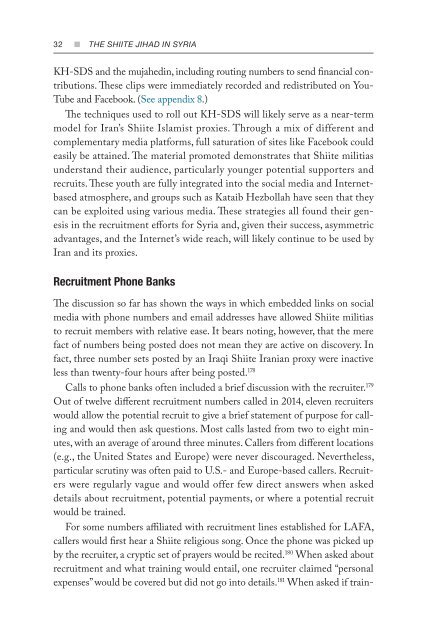Create successful ePaper yourself
Turn your PDF publications into a flip-book with our unique Google optimized e-Paper software.
32 n <strong>THE</strong> <strong>SHIITE</strong> <strong>JIHAD</strong> <strong>IN</strong> <strong>SYRIA</strong><br />
KH-SDS and the mujahedin, including routing numbers to send financial contributions.<br />
These clips were immediately recorded and redistributed on You-<br />
Tube and Facebook. (See appendix 8.)<br />
The techniques used to roll out KH-SDS will likely serve as a near-term<br />
model for Iran’s Shiite Islamist proxies. Through a mix of different and<br />
complementary media platforms, full saturation of sites like Facebook could<br />
easily be attained. The material promoted demonstrates that Shiite militias<br />
understand their audience, particularly younger potential supporters and<br />
recruits. These youth are fully integrated into the social media and Internetbased<br />
atmosphere, and groups such as Kataib Hezbollah have seen that they<br />
can be exploited using various media. These strategies all found their genesis<br />
in the recruitment efforts for Syria and, given their success, asymmetric<br />
advantages, and the Internet’s wide reach, will likely continue to be used by<br />
Iran and its proxies.<br />
Recruitment Phone Banks<br />
The discussion so far has shown the ways in which embedded links on social<br />
media with phone numbers and email addresses have allowed Shiite militias<br />
to recruit members with relative ease. It bears noting, however, that the mere<br />
fact of numbers being posted does not mean they are active on discovery. In<br />
fact, three number sets posted by an Iraqi Shiite Iranian proxy were inactive<br />
less than twenty-four hours after being posted. 178<br />
Calls to phone banks often included a brief discussion with the recruiter. 179<br />
Out of twelve different recruitment numbers called in 2014, eleven recruiters<br />
would allow the potential recruit to give a brief statement of purpose for calling<br />
and would then ask questions. Most calls lasted from two to eight minutes,<br />
with an average of around three minutes. Callers from different locations<br />
(e.g., the United States and Europe) were never discouraged. Nevertheless,<br />
particular scrutiny was often paid to U.S.- and Europe-based callers. Recruiters<br />
were regularly vague and would offer few direct answers when asked<br />
details about recruitment, potential payments, or where a potential recruit<br />
would be trained.<br />
For some numbers affiliated with recruitment lines established for LAFA,<br />
callers would first hear a Shiite religious song. Once the phone was picked up<br />
by the recruiter, a cryptic set of prayers would be recited. 180 When asked about<br />
recruitment and what training would entail, one recruiter claimed “personal<br />
expenses” would be covered but did not go into details. 181 When asked if train-


